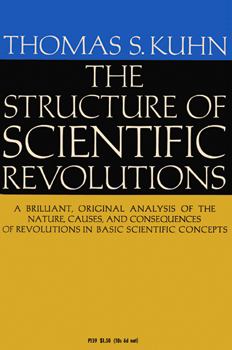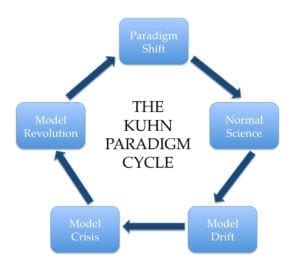Thomas Kuhn Uses the Term Scientific Revolution to Describe Th
The Structure of Scientific Revolutions Thomas Kuhn 1962 is an analysis of the history of science. Theory of scientific revolutions.

Pattern Of Scientific Revolution Source Thomas Kuhn 1970 Download Scientific Diagram
Thomas Samuel Kuhn 19221996 is one of the most influential philosophers of science of the twentieth century perhaps the most influential.

. These two aspects are intimately related and the key concept that Kuhn develops is that of paradigm -- a reigning or dominant approach to solving problems in a given area of science. Moreover in a political revolution one set of institutions replaces anotherbut only after a temporary gap. Beginning with Nicholas Copernicus who presented a heliocentric cosmos and it ended with Issac Newton who proposed universal laws and a Mechanical Universe.
In his book Kuhn outlined a revolutionary model of scientific change and examined the role of the scientific community in preventing and then accepting change. In fact scientific revolutions are akin to political revolutions in that both see communities beginning to doubt or grow frustrated with established institutions. Kuhn presented his notion of a paradigm shift in his influential book The Structure of Scientific Revolutions 1962.
Kuhn presented his views in Structure of Scientific Revolutions first edition 1962 second edition 1970. Fourth edition 2012 is a book about the history of science by philosopher Thomas S. This paper will evaluate Kuhns notion of scientific revolution particularly paradigm normal science crisis and incommensurability.
Kuhn argued that his use of the term revolution to describe changes in science is appropriate because like political revolutions scientific revolutions overturn existing rules and institutions in order to establish new ones. The Scientific Revolution refers to the historical changes in thought and belief to changes in social and institutional organizations that came upon in Europe between roughly 1550-1700. In philosophy of science.
He challenges the normally accepted scientific beliefs. This theory is what he called paradigm. The science advances when a scientific revolution takes place after silent period of normal science and the scientific community moves ahead to a paradigm shift.
The Scientific Community According to Kuhn a scientific discipline is defined socially. The work of Thomas Kuhn. Kuhns contribution to the philosophy of science marked not only a break with several key positivist doctrines but.
In Thomas Kuhns Structure of Scientific Revolutions 1 he uses the concept of a paradigm to describe how scientific fields undergo crisis upheaval and eventual revolution. Its publication was a landmark event in the sociology of knowledge and popularized the terms paradigm and paradigm shift. Kuhns notion as stated above is contrary to the popular image of science.
It is a particular scientific community united by education eg texts methods of accreditation professional interaction and communication eg journals conventions as well as similar interests in problems of a certain sort and acceptance of a. Kuhn contrasts paradigm shifts which characterize a scientific revolution to the activity of normal science which he describes as scientific work done within a prevailing framework or paradigm. With the structure of scientific revolutions kuhn challenged long-standing linear notions of scientific progress arguing that transformative ideas dont arise from the day-to-day gradual process.
Walewangko Riwayat Hidup Thomas Samuel Kuhn lahir pada 18 Juli 1922 di Cincinnati Ohio Amerika Serikat 1949. Its publication was a landmark event in the history philosophy and sociology of science. In Thomas Kuhns The Structure of Scientific Revolutions Kuhn states that a paradigm shift is a revolutionary event as it causes the rise in a new era of science.
Thomas Kuhn 1922-1996 argued that scientific advancement is not evolutionary but rather is a series of peaceful interludes punctuated by intellectually violent revolutions and in those revolutions one conceptual world view is replaced by another. Anita Tengker Lady Giroth Stief A. Paradigm shifts arise when the dominant paradigm under which.
Kuhn challenged the then prevailing view of progress in science in which scientific progress. Kuhn explains his choice of the word revolution which immediately suggests a parallel to politics. His 1962 book The Structure of Scientific Revolutions is one of the most cited academic books of all time.
The Structure of Scientific Revolutions 1962. Kuhn states clearly the fundamental objective of The Structure of Scientific Revolutions as that of urging a change in the per- ception and evaluation of familiar data ppx-xi. Inquiries in a given field start with a clash of different perspectives.
In 1962 a new historiography-of-science emerged with Thomas Kuhns The Structure of Scientific Revolutions first published as part of the Foundations of the Unity of Science series. He states that if scientific discoveries are typically viewed as novelties then this will lead to the end of what people believe to be normal science. A scientific revolution is when an older paradigm is replaced completely or partially by a new paradigm.
A full understanding of this process and how it relates to the history of our field is necessary to understand how psychiatry has changed and may change again. The Structure of Scientific Revolution Presented by Kelompok 1. Thomas Kuhn pg 52.
He argued that scientific revolutions proceed through the following stages. In Kuhn s postscript to The Structure of Scientific Revolutions he uses the term disciplinary matrix to clarify what he initially meant by paradigm. The Structure of Scientific Revolutions offered a general pattern of scientific change.
According to Thomas Kuhn the scientific progress of any discipline could be distinguished by a pre-paradigm phase a normal science phase and a revolution phase. Cover of 3rd edition paperback. Eventually one approach manages to resolve some concrete issue and investigators concur in pursuing itthey follow the paradigm.
As the understanding of science change the more humans switch their world view. Thus causing the rift between the. Kuhn believed that a mature science must experience interchanging phases of normal science and revolution.
Like paradigms disciplinary matrices describe groups of scientists read analysis of Disciplinary Matrix. He exemplifies his scientific paradigms by re-evaluating normal science -.

Pattern Of Scientific Revolution Source Thomas Kuhn 1970 Download Scientific Diagram

The Structure Of Scientific Revolutions Wikiwand

Objections To Kuhn S Theory Of Scientific Progression Hektoen International
No comments for "Thomas Kuhn Uses the Term Scientific Revolution to Describe Th"
Post a Comment